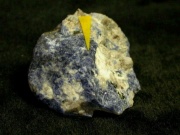Difference between revisions of "Sodalite"
m (Text replace - "== Authority ==" to "== Sources Checked for Data in Record ==") |
m (Text replace - "\[http:\/\/cameo\.mfa\.org\/materials\/fullrecord\.asp\?name=([^\s]+)\s(.*)\]" to "$2") |
||
| Line 2: | Line 2: | ||
== Description == | == Description == | ||
| − | A blue, glassy mineral of sodium aluminum silicate that has been used as a [ | + | A blue, glassy mineral of sodium aluminum silicate that has been used as a [[gemstone|gemstone]] and for ornamentation. Sodalite was discovered in Greenland in 1806. It is produced in soda rich magmas and other deposits have been found near Vesuvius, in Norway, Romania, Portugal, Russia, Bolivia, Brazil, Canada (Ontario, Quebec, British Columbia) and the U.S. (Maine). Sodalite resembles [[lapis%20lazuli|lapis lazuli]], but is harder and does not contain the gold colored iron [[pyrite|pyrite]] flecks. Hackmanite, a variety of sodalite, fades to white when exposed to light but will regain its dark blue color when left in the dark. |
[[File:ps30320sodalite2.jpg|thumb|Sodalite]] | [[File:ps30320sodalite2.jpg|thumb|Sodalite]] | ||
Revision as of 12:15, 10 May 2016
Description
A blue, glassy mineral of sodium aluminum silicate that has been used as a Gemstone and for ornamentation. Sodalite was discovered in Greenland in 1806. It is produced in soda rich magmas and other deposits have been found near Vesuvius, in Norway, Romania, Portugal, Russia, Bolivia, Brazil, Canada (Ontario, Quebec, British Columbia) and the U.S. (Maine). Sodalite resembles Lapis lazuli, but is harder and does not contain the gold colored iron Pyrite flecks. Hackmanite, a variety of sodalite, fades to white when exposed to light but will regain its dark blue color when left in the dark.
Synonyms and Related Terms
scapolite; Princess blue; hackmanite; sodalita (Esp.); sodalite (Fr., Port.); Sodalit (Deut.)
Other Properties
Isometric system found as dodecahedrons or masses. Fluorescent (patchy orange).
Streak = white. Fracture = conchoidal or uneven. Luster = vitreous to greasy. Flame = yellow (sodium color)
| Composition | Na4Al3(SiO4)3Cl |
|---|---|
| Mohs Hardness | 5.5 - 6.0 |
| Density | 2.14-2.50 |
| Refractive Index | 1.483-1.487 |
Additional Information
Mineralogy Database: Sodalite
Additional Images
Sources Checked for Data in Record
- Jack Odgen, Jewellery of the Ancient World, Rizzoli International Publications Inc., New York City, 1982
- Frank A. Lent, Trade names and Descriptions of Marbles, Limestones, Sandstones, Granites and Other Building Stones Quarried in the United States Canada and other Countries., Stone Publishing Co, New York, 1925
- Encyclopedia Britannica, http://www.britannica.com Comment: "sodalite" Encyclopædia Britannica [Accessed December 4, 2001].
- C.W.Chesterman, K.E.Lowe, Audubon Society Field Guide to North American Rocks and Minerals, Alfred A. Knopf, New York, 1979
- Wikipedia, the free encyclopedia, at http://www.wikipedia.com Comment: http://en.wikipedia.org/wiki/Sodalite (Accessed Sept. 17, 2005)
- Van Nostrand's Scientific Encyclopedia, Douglas M. Considine (ed.), Van Nostrand Reinhold, New York, 1976



